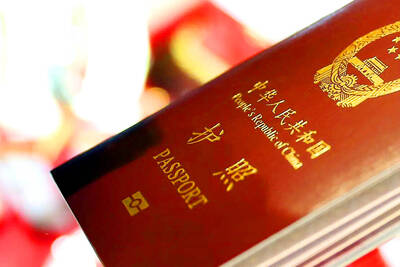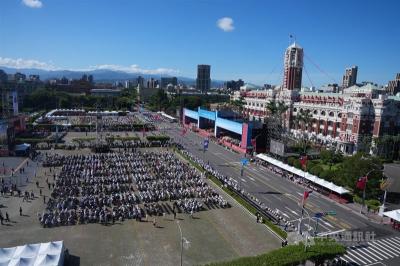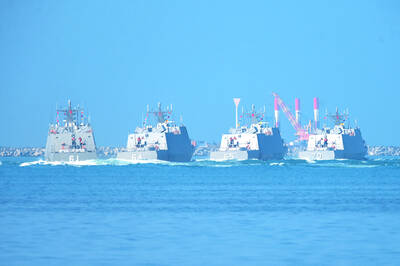North Korea will turn US military bases in the region into a "sea of fire" if war breaks out on the Korean Peninsula, North Korean media yesterday quoted a communist officer as saying.
The North's state-run news media highlighted the comment hours after South Korea released a new defense policy paper that revealed a US reinforcement plan to dispatch 690,000 troops and 2,000 warplanes if war breaks out.
North Korea's saber-rattling rhetoric comes as the isolated North is urging its military to prepare for what it calls a US plan to invade. Washington and its allies say they are trying to end the North's nuclear-weapons programs through multinational disarmament talks.
"If the US imperialists ignite flames of war, we will first of all strike all bases of US imperialist aggressors and turn them into a sea of fire," North Korea's Central Radio quoted officer Hur Ryong as saying, according to the South Korean news agency Yonhap.
Hur was also quoted as saying the North Korean military would "thoroughly incinerate the aggressor elements that collude with the US imperialists," in an apparent reference to South Korea and Japan, both of which host US military bases.
Hur made his comment on Wednesday during a debate in Pyongyang on North Korean leader Kim Jong-il's "army-first" strategy that stresses military strength.
Earlier yesterday, South Korea released its new defense white paper that mirrored its efforts to redefine a half-century-old confrontation with the communist North as well as adjust its alliance with the US.
The white paper, which has been updated for the first time in four years, removes 10-year-old references to North Korea being the South's "main enemy," though it still calls the North a "direct military threat."
The removal of the "main enemy" term is largely symbolic but reflects South Korea's efforts at fostering reconciliation with North Korea.
The commitment of US troops in the event of war appears aimed at easing concerns that Washington's plan to expand the role of US troops in South Korea from guarding against the North into rapid regional redeployments could create a security vacuum in this enduring Cold War flashpoint.
"The reinforcement plan reflects a strong US commitment to defending South Korea," the South Korean white paper said.
North Korea, which accuses the US and South Korea of preparing to invade over its nuclear-weapons programs, has added more artillery pieces and missiles to its Korean People's Army, already the world's fifth-largest, it said.
About 300 of the North's 1,000 long-range artillery and multiple-launch rockets are deployed along the border near Seoul. Those missiles, capable of raining down shells and rockets on the South Korean capital only 50km from the border, is the most formidable defense concern for South Korea.
The number of North Korean troops remained unchanged at 1.17 million, but the North has reorganized its military to add eight new divisions, most of them units with missiles capable of hitting South Korea and Japan, officials said.
North Korea, although impoverished and dependent on outside aid to feed its 22 million people, still poses a serious security threat.
Leader Kim Jong-il ensures the Korean People's Army, the backbone of his Stalinist rule, gets the best food and largest spending out of the official budget and from a network of illegal trading in counterfeit dollars, drugs and missile technology.

The Ministry of the Interior (MOI) is to tighten rules for candidates running for public office, requiring them to declare that they do not hold a Chinese household registration or passport, and that they possess no other foreign citizenship. The requirement was set out in a draft amendment to the Enforcement Rules of the Public Officials Election and Recall Act (公職人員選舉罷免法 ) released by the ministry on Thursday. Under the proposal, candidates would need to make the declaration when submitting their registration forms, which would be published in the official election bulletin. The move follows the removal of several elected officials who were

The Republic of China (ROC) is celebrating its 114th Double Ten National Day today, featuring military parades and a variety of performances and speeches in front of the Presidential Office in Taipei. The Taiwan Taiko Association opened the celebrations with a 100-drummer performance, including young percussionists. As per tradition, an air force Mirage 2000 fighter jet flew over the Presidential Office as a part of the performance. The Honor Guards of the ROC and its marching band also heralded in a military parade. Students from Taichung's Shin Min High School then followed with a colorful performance using floral imagery to represent Taiwan's alternate name

FOUR DESIGNATED AREAS: Notices were issued for live-fire exercises in waters south and northwest of Penghu, northeast of Keelung and west of Kaohsiung, they said The military is planning three major annual exercises across the army, navy and air force this month, with the navy’s “Hai Chiang” (海強, “Sea Strong”) drills running from today through Thursday, the Ministry of National Defense said yesterday. The Hai Chiang exercise, which is to take place in waters surrounding Taiwan, would feature P-3C Orion maritime patrol aircraft and S-70C anti-submarine helicopters, the ministry said, adding that the drills aim to bolster the nation’s offshore defensive capabilities. China has intensified military and psychological pressure against Taiwan, repeatedly sending warplanes and vessels into areas near the nation’s air defense identification zone and across

A Chinese takeover of Taiwan would severely threaten the national security of the US, Japan, the Philippines and other nations, while global economic losses could reach US$10 trillion, National Security Council Deputy Secretary-General Lin Fei-fan (林飛帆) wrote in an article published yesterday in Foreign Affairs. “The future of Taiwan is not merely a regional concern; it is a test of whether the international order can withstand the pressure of authoritarian expansionism,” Lin wrote in the article titled “Taiwan’s Plan for Peace Through Strength — How Investments in Resilience Can Deter Beijing.” Chinese President Xi Jinping’s (習近平) intent to take Taiwan by force